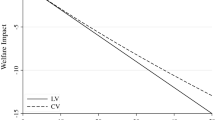Abstract
A well-known result with important policy implications is that an output increase is a necessary condition for social welfare to increase with third-degree price discrimination. In this paper, we explore the robustness of this result to the introduction of an assumption that is different than the conventional approach, namely preferences not being quasilinear. We show that in the presence of income differences among consumers, the aggregate utility of consumers may increase with price discrimination while total output remains constant. This result questions the general policy recommendation that third-degree price discrimination should be disapproved because it reduces welfare unless output increases. Our result highlights the crucial role of the assumption of quasilinear preferences in standard welfare calculations. In the presence of income differences, consumer surplus may be a biased welfare measure, thus potentially leading to incorrect conclusions when assessing the impact of specific policies.
Similar content being viewed by others
Notes
Notice further that various theoretical analyses have been based upon the condition that the incremental consumer’s surplus is independent of the consumer’s income. See, for instance, Willig (1978). Also Foster and Neuburger (1974) address the problems with the behavior of the marginal utility of money. They actually refer to the fact that: “Marshall originally developed his consumer surplus as a measure of cardinal utility. In order to do this he required the condition of constant marginal utility of money. Thus, for him the measure was never anything but a good approximation”.
References
Adachi, T. (2005). Third-degree price discrimination, consumption externalities and social welfare. Economica, 72(285), 171–178.
Aguirre, I., Cowan, S., & Vickers, J. (2010). Monopoly price discrimination and demand curvature. American Economic Review, 100(4), 1601–1615.
Cowan, S. (2018). Regulating monopoly price discrimination. Journal of Regulatory Economics, 54(1), 1–13.
Foster, C. D., & Neuburger, H. L. I. (1974). The ambiguity of the consumer’s surplus measure of welfare change. Oxford Economic Papers, 26(1), 66–77.
Galera, F., Kinateder, M., & Mendi, P. (2014). The cost effect in third-degree price discrimination. Journal of Economics, 113(2), 175–186.
Galera, F., Mendi, P., & Molero, J. C. (2017a). Quality differences, third-degree price discrimination, and welfare. Economic Inquiry, 55(1), 339–351.
Galera, F., Mendi, P., & Molero, J. C. (2017b). Seasonality, price discrimination, and welfare. Journal of Economics, 120(3), 269–277.
Galera, F., & Zaratiegui, J. M. (2006). Welfare and output in third-degree price discrimination: A note. International Journal of Industrial Organization, 24(3), 605–611.
Mankiw, N. (2014). Principles of microeconomics. Boston: Cengage Learning.
Marshall, A. (1890). Principles of economics. London: Macmillan and Company.
Mas-Colell, A., Whinston, M., & Green, J. (1995). Microeconomic theory. Oxford: Oxford University Press.
OECD (2016). Price discrimination. In Background note by the Secretariat. Technical report, Competition Committee, Directorate for Financial and Enterprise Affairs. https://one.oecd.org/document/DAF/COMP(2016)15/en/pdf. Accessed 21 June 2017.
Pindyck, R., & Rubinfeld, D. (2012). Microeconomics. London: Pearson Education.
Schmalensee, R. (1981). Output and welfare implications of monopolistic third-degree price discrimination. American Economic Review, 71(1), 242–247.
Varian, H. R. (1985). Price discrimination and social welfare. American Economic Review, 75(4), 870–875.
Willig, R. D. (1976). Consumer’s surplus without apology. American Economic Review, 66(4), 589–597.
Willig, R. D. (1978). Incremental consumer’s surplus and hedonic price adjustment. Journal of Economic Theory, 17(2), 227–253.
Wright, P. G. (1917). Total utility and consumers’ surplus under varying conditions of the distribution of income. Quarterly Journal of Economics, 31, 307–318.
Author information
Authors and Affiliations
Corresponding author
Additional information
Publisher's Note
Springer Nature remains neutral with regard to jurisdictional claims in published maps and institutional affiliations.
We thank the Editor, Menahem Spiegel, and an anonymous referee for their suggestions, which substantially improved the quality of the paper. Mendi gratefully acknowledges financial support from Fundación Ramón Areces. All errors are our own.
Rights and permissions
About this article
Cite this article
Galera, F., Garcia-del-Barrio, P. & Mendi, P. Consumer surplus bias and the welfare effects of price discrimination. J Regul Econ 55, 33–45 (2019). https://doi.org/10.1007/s11149-019-09376-x
Published:
Issue Date:
DOI: https://doi.org/10.1007/s11149-019-09376-x




